University of Birmingham
 | ||||||||||||||||||||||||||||||||||||||||||||||||||||||||||||||||||||||||||||||||||||||||||||
| Motto | Latin:Per Ardua ad Alta | |||||||||||||||||||||||||||||||||||||||||||||||||||||||||||||||||||||||||||||||||||||||||||
|---|---|---|---|---|---|---|---|---|---|---|---|---|---|---|---|---|---|---|---|---|---|---|---|---|---|---|---|---|---|---|---|---|---|---|---|---|---|---|---|---|---|---|---|---|---|---|---|---|---|---|---|---|---|---|---|---|---|---|---|---|---|---|---|---|---|---|---|---|---|---|---|---|---|---|---|---|---|---|---|---|---|---|---|---|---|---|---|---|---|---|---|---|
Motto in English | Through efforts to heights[1] | |||||||||||||||||||||||||||||||||||||||||||||||||||||||||||||||||||||||||||||||||||||||||||
| Type | Public | |||||||||||||||||||||||||||||||||||||||||||||||||||||||||||||||||||||||||||||||||||||||||||
| Established |
| |||||||||||||||||||||||||||||||||||||||||||||||||||||||||||||||||||||||||||||||||||||||||||
| Endowment | £142.5 million (2023)[4] | |||||||||||||||||||||||||||||||||||||||||||||||||||||||||||||||||||||||||||||||||||||||||||
| Budget | £909.1 million (2022/23)[4] | |||||||||||||||||||||||||||||||||||||||||||||||||||||||||||||||||||||||||||||||||||||||||||
| Chancellor | Lord Bilimoria[5] | |||||||||||||||||||||||||||||||||||||||||||||||||||||||||||||||||||||||||||||||||||||||||||
| Vice-Chancellor | Adam Tickell | |||||||||||||||||||||||||||||||||||||||||||||||||||||||||||||||||||||||||||||||||||||||||||
| Visitor | The Rt HonPenny MordauntMP (asLord President of the Councilex officio) | |||||||||||||||||||||||||||||||||||||||||||||||||||||||||||||||||||||||||||||||||||||||||||
Academic staff | 4,100 (2021/22)[6] | |||||||||||||||||||||||||||||||||||||||||||||||||||||||||||||||||||||||||||||||||||||||||||
| Students | 37,990 (2021/22)[7] | |||||||||||||||||||||||||||||||||||||||||||||||||||||||||||||||||||||||||||||||||||||||||||
| Undergraduates | 25,150 (2021/22)[7] | |||||||||||||||||||||||||||||||||||||||||||||||||||||||||||||||||||||||||||||||||||||||||||
| Postgraduates | 12,840 (2021/22)[7] | |||||||||||||||||||||||||||||||||||||||||||||||||||||||||||||||||||||||||||||||||||||||||||
| Location | , England 52°27′2″N1°55′50″W/ 52.45056°N 1.93056°W | |||||||||||||||||||||||||||||||||||||||||||||||||||||||||||||||||||||||||||||||||||||||||||
| Campus | Urban, suburban | |||||||||||||||||||||||||||||||||||||||||||||||||||||||||||||||||||||||||||||||||||||||||||
| Colours | The University
College scarves
| |||||||||||||||||||||||||||||||||||||||||||||||||||||||||||||||||||||||||||||||||||||||||||
| Affiliations | ||||||||||||||||||||||||||||||||||||||||||||||||||||||||||||||||||||||||||||||||||||||||||||
| Website | birmingham | |||||||||||||||||||||||||||||||||||||||||||||||||||||||||||||||||||||||||||||||||||||||||||
 | ||||||||||||||||||||||||||||||||||||||||||||||||||||||||||||||||||||||||||||||||||||||||||||
TheUniversity of Birmingham(informallyBirmingham University)[8][9]is apublicresearch universityinBirmingham,England. It received itsroyal charterin 1900 as a successor toQueen's College, Birmingham(founded in 1825 as theBirmingham School of Medicine and Surgery), andMason Science College(established in 1875 by SirJosiah Mason), making it the first Englishcivic or 'red brick' universityto receive its own royal charter, and the first Englishunitary university.[2][10][11]It is a founding member of both theRussell Groupof British research universities and the international network of research universities,Universitas 21.
The student population includes 23,155 undergraduate and 12,605 postgraduate students in 2019–20, which is the7th largestin the UK (out of 169). The annual income of the university for 2022–23 was £909.1 million of which £196.7 million was from research grants and contracts, with an expenditure of £884.7 million.[4]In the 2021Research Excellence Framework,the University of Birmingham ranked equal 13th out of 129 institutions on grade point average, up from equal 31st in the previous REF in 2014.[12]
The university is home to theBarber Institute of Fine Arts,housing works byVan Gogh,PicassoandMonet;theShakespeare Institute;the Cadbury Research Library, theMingana Collectionof Middle Eastern manuscripts; theLapworth Museum of Geology;and the 100-metreJoseph Chamberlain Memorial Clock Tower,which is a prominent landmark visible from many parts of the city.[13]Academicsandalumniof the university include former British Prime MinistersNeville ChamberlainandStanley Baldwin,[14]the British composerSir Edward Elgarand elevenNobel laureates.[15]
History[edit]
Queen's College[edit]
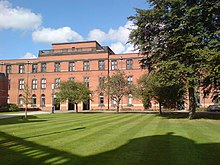
The earliest beginnings of the university were originally traced back to theQueen's College,which is linked toWilliam Sands Coxin his aim of creating a medical school along strictly Christian lines, unlike the contemporary London medical schools.[citation needed]Further research[by whom?]revealed the roots of theBirmingham Medical Schoolin the medical education seminars of John Tomlinson, the first surgeon to theBirmingham Workhouse Infirmary,and later to theBirmingham General Hospital.These classes, held in the winter of 1767–68, were the first such lectures ever held in England or Wales. The first clinical teaching was undertaken by medical apprentices at the General Hospital, founded in 1779. The medical school which grew out of theBirminghamWorkhouse Infirmary was founded in 1828, but Cox began teaching in December 1825.Queen Victoriagranted her patronage to the Clinical Hospital in Birmingham and allowed it to be styled "The Queen's Hospital". It was the first provincial teaching hospital in England. In 1843, the medical college became known as Queen's College.[16]
Mason Science College[edit]
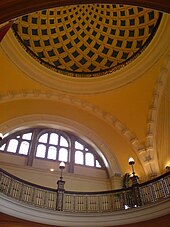
In 1870, SirJosiah Mason,the Birminghamindustrialistand philanthropist, who made his fortune in making key rings, pens, pen nibs and electroplating, drew up the Foundation Deed forMason Science College.[3]The college was founded in 1875.[2]It was this institution that would eventually form the nucleus of the University of Birmingham. In 1882, the Departments of Chemistry, Botany and Physiology were transferred to Mason Science College, soon followed by the Departments of Physics andComparative Anatomy.The transfer of the Medical School to Mason Science College gave considerable impetus to the growing importance of that college and in 1896 a move to incorporate it as auniversity collegewas made. As the result of theMason University College Act 1897(60 & 61 Vict.c. xx) it became incorporated as Mason University College on 1 January 1898, withJoseph Chamberlainbecoming the President of its Court of Governors.
Royal charter[edit]
| Birmingham University Act 1900 | |
|---|---|
| Act of Parliament | |
 | |
| Long title | An Act to transfer all the property and liabilities of Mason University College in the city of Birmingham to the University of Birmingham and to repeal the Mason University College Act 1897 to confer certain powers on the said University and for other purposes. |
| Citation | 63 & 64 Vict.c. xix |
| Dates | |
| Royal assent | 25 May 1900 |
| Other legislation | |
| Repeals/revokes | Mason University College Act 1897 |
It was largely due to Chamberlain's enthusiasm that the university was granted aroyal charterbyQueen Victoriaon 24 March 1900.[17]TheCalthorpe familyoffered twenty-five acres (10 hectares) of land on theBournbrookside of their estate in July. The Court of Governors received theBirmingham University Act 1900(63 & 64 Vict.c. xix), which put the royal charter into effect on 31 May.
The transfer of Mason University College to the new University of Birmingham, with Chamberlain as its firstchancellorand SirOliver Lodgeas the firstprincipal,was complete. A remnant of Josiah Mason's legacy is the Mermaid from his coat-of-arms, which appears in the sinister chief of the university shield and of his college, the double-headed lion in the dexter.[18]
The commerce faculty was founded by SirWilliam Ashleyin 1901, who from 1902 until 1923 served as first Professor of Commerce and Dean of the Faculty. From 1905 to 1908,Edward Elgarheld the position of Peyton Professor of Music at the university. He was succeeded by his friendGranville Bantock.[19]
The university's own heritage archives are accessible for research through the university's Cadbury Research Library which is open to all interested researchers.[20]
During theFirst World War,the Great Hall in the Aston Webb Building was requisitioned by theWar Officeto create the 1st Southern General Hospital, a facility for theRoyal Army Medical Corpsto treat military casualties; it was equipped with 520 beds and treated 125,000 injured servicemen.[21]
In June 1921, the university appointedLinetta de CastelvecchioasSerena Professor of Italian:she was the first woman to hold a chair at the university and one of the first women professors in Great Britain.[22][23]
Expansion[edit]
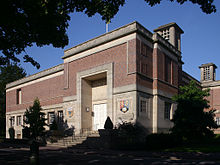
In 1939, theBarber Institute of Fine Arts,designed byRobert Atkinson,was opened. In 1956, the first MSc programme inGeotechnical Engineeringcommenced under the title of "Foundation Engineering", and has been run annually at the university since.
The UK's longest-running MSc programme in Physics and Technology of Nuclear Reactors also started at the university in 1956, the same year that the world's first commercial nuclear power station was opened atCalder Hallin Cumbria.
In 1957, SirHugh Cassonand Neville Conder were asked by the university to prepare a masterplan on the site of the original 1900 buildings which were incomplete. The university drafted in other architects to amend the masterplan produced by the group. During the 1960s, the university constructed numerous large buildings, expanding the campus.[24]In 1963, the university helped in the establishment of the faculty of medicine at the University of Rhodesia, now theUniversity of Zimbabwe(UZ). UZ is now independent but both institutions maintain relations through student exchange programmes.
Birmingham also supported the creation ofKeele University(formerly University College of North Staffordshire) and theUniversity of Warwickunder the Vice-Chancellorship of Sir Robert Aitken who acted as 'godfather' to the University of Warwick.[25]The initial plan was to establish a satellite university college inCoventrybut Aitken advised an independent initiative to the University Grants Committee.[26]
Malcolm X,the Afro-American human rights activist, addressed the University Debating Society in 1965.[21]
Scientific discoveries and inventions[edit]
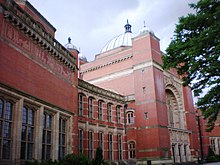
The university has been involved in many scientific breakthroughs and inventions. From 1925 until 1948, SirNorman Haworthwas Professor and Director of the Department of Chemistry. He was appointed Dean of the Faculty of Science and acted as Vice-Principal from 1947 until 1948. His research focused predominantly oncarbohydrate chemistryin which he confirmed a number of structures of optically active sugars. By 1928, he had deduced and confirmed the structures ofmaltose,cellobiose,lactose,gentiobiose,melibiose,gentianose,raffinose,as well as theglucosidering tautomeric structure of aldose sugars. His research helped to define the basic features of thestarch,cellulose,glycogen,inulinandxylanmolecules. He also contributed towards solving the problems with bacterial polysaccharides. He was a recipient of theNobel Prize in Chemistryin 1937.[27]
Thecavity magnetronwas developed in the Department of Physics by SirJohn Randall,Harry BootandJames Sayers.This was vital to the Allied victory in World War II. In 1940, theFrisch–Peierls memorandum,a document which demonstrated that theatomic bombwas more than simply theoretically possible, was written in the Physics Department by SirRudolf PeierlsandOtto Frisch.The university also hosted early work ongaseous diffusionin the Chemistry department when it was located in the Hills building.
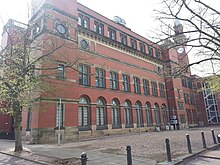
Physicist SirMark Oliphantmade a proposal for the construction of a proton-synchrotronin 1943; however, he made no assertion that the machine would work. In 1945, phase stability was discovered; consequently, the proposal was revived, and construction of a machine that could surpass proton energies of 1GeVbegan at the university. However, because of lack of funds, the machine did not start until 1953. TheBrookhaven National Laboratorymanaged to beat them; they started theirCosmotronin 1952, and had it entirely working in 1953, before the University of Birmingham.[28]
In 1947, SirPeter Medawarwas appointed Mason Professor of Zoology at the university. His work involved investigating the phenomenon of tolerance and transplantation immunity. He collaborated withRupert E. Billinghamand they did research on problems of pigmentation andskin graftingin cattle. They used skin grafting to differentiate between monozygotic and dizygotic twins in cattle. Taking the earlier research of R. D. Owen into consideration, they concluded that actively acquired tolerance of homografts could be artificially reproduced. For this research, Medawar was elected aFellow of the Royal Society.He left Birmingham in 1951 and joined the faculty atUniversity College London,where he continued his research on transplantation immunity. He was a recipient of theNobel Prize in Physiology or Medicinein 1960.[29]
Recent history[edit]

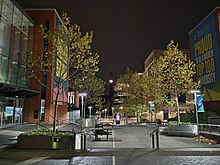
In 1999 talks commenced on the possibility ofAston Universityintegrating itself into the University of Birmingham as the University of Birmingham, Aston Campus. This would have resulted in the University of Birmingham expanding to become one of the largest universities in the UK, with a student body of 30,000. Talks were halted in 2001 after Aston University determined the timing to be inopportune. While Aston University management was in favour of the integration, and reception among staff was generally positive, the Aston student union voted two-to-one against the integration. Despite this set back, the Vice Chancellor of the University of Birmingham said the door remained open to recommence talks when Aston University is ready.[30]
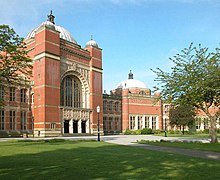
Thefinal roundof the first ever televised leaders' debates, hosted by theBBC,was held at the university during the2010 British general electioncampaign on 29 April 2010.[31][32]
On 9 August 2010 the university announced that for the first time it would not enter theUCAS clearingprocess for 2010 admission, which matches under-subscribed courses to students who did not meet their firm or insurance choices, due to all places being taken. Largely a result of thefinancial crisis of 2007–2010,Birmingham joined fellow Russell Group universities including Oxford, Cambridge, Edinburgh and Bristol in not offering any clearing places.[33]
The university acted as a training camp for theJamaicanathletics team prior to the2012 London Olympics.[34]
A new library was opened for the 2016/17 academic year, and a new sports centre opened in May 2017.[35]The previous Main Library and the old Munrow Sports Centre, including the athletics track, have both since been demolished, with the demolition of the old library being completed in November 2017.[36]
Controversies[edit]
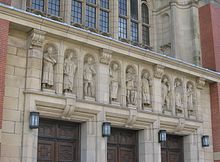
The discipline ofcultural studieswas founded at the university and between 1964 and 2002 the campus was home to theCentre for Contemporary Cultural Studies,a research centre whose members' work came to be known as the Birmingham School of Cultural Studies. Despite being established by one of the key figures in the field,Richard Hoggart,and being later directed by the theoristStuart Hall,the department was controversially closed down.[37]
Analysis showed that the university was fourth in a list of British universities that faced the mostemployment tribunalclaims between 2008 and 2011. They were the second most likely to settle these before the hearing date.[38]
In 2011 a parliamentaryearly day motionwas proposed, arguing against the Guild suspending the elected Sabbatical Vice President (Education), who was arrested while taking part in protest activity.[39]
In December 2011 it was announced that the university had obtained a 12-month-long injunction[40]against a group of around 25 students, who occupied a residential building on campus from 23 to 26 November 2011, preventing them from engaging in further "occupational protest action" on the university's grounds without prior permission. It was misreported in the press that this injunction applied to all students; however, the court order defines the defendants as:
Persons unknown (including students of the University of Birmingham) entering or remaining upon the buildings known as No. 2 Lodge Pritchatts Road, Birmingham at the University of Birmingham for the purpose of protest action (without the consent of the University of Birmingham).[41]
The university and the Guild of Students also clarified the scope of the injunction in an e-mail sent to all students on 11 January 2012, stating: "The injunction applies only to those individuals who occupied the lodge".[42]The university said that it sought this injunction as a safety precaution based on a previous occupation.[43]Three separate human rights groups, includingAmnesty International,condemned the move as restrictive on human rights.[44]
In 2019, several women said the university refused to investigate allegations ofcampus rape.One student who complained of rape in university accommodation was told by employees of the university that there were no specific procedures for handling rape complaints. In other cases students were told they would have to prove the alleged rapes occurred on university property. The university has been criticized by legal professionals for not adequately assessing the risk to students by refusing to investigate complaints of criminal conduct.[45]
In June 2022 the University published a report into, and apologised for, its involvement in developing, promoting and administering electric-shockconversion therapyto gay men, during the period 1966-1983.[46][47]
Campuses[edit]
Edgbaston campus[edit]
Original buildings[edit]

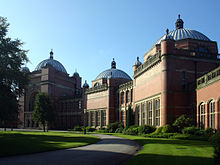
The main campus of the university occupies a site some 3 miles (4.8 km) south-west ofBirmingham city centre,inEdgbaston.It is arranged aroundJoseph Chamberlain Memorial Clock Tower(affectionately known as 'Old Joe' or 'Big Joe'), a grandcampanilewhich commemorates the university's first chancellor,Joseph Chamberlain.[48]Chamberlain may be considered the founder of Birmingham University, and was largely responsible for the university gaining its Royal Charter in 1900 and for the development of the Edgbaston campus. The university's Great Hall is located in the domedAston WebbBuilding, which is named after one of the architects – the other wasIngress Bell.The initial 25-acre (100,000 m2) site was given to the university in 1900 by Lord Calthorpe. The grand buildings were an outcome of the £50,000 given by steel magnate and philanthropistAndrew Carnegieto establish a "first class modern scientific college"[49]on the model ofCornell Universityin the United States.[50]Funding was also provided by SirCharles Holcroft.[51]
The original domed buildings, built inAccrington red brick,semicircle to form Chancellor's Court. This sits on a 30 feet (9.1 m) drop, so the architects placed their buildings on two tiers with a 16 feet (4.9 m) drop between them. The clock tower stands in the centre of the Court.
The campanile itself draws its inspiration from theTorre del Mangia,a medieval clock tower that forms part of theTown HallinSiena,Italy.[52]When it was built, it was described as 'the intellectual beacon of the Midlands' by theBirmingham Post.The clock tower was Birmingham's tallest building from the date of its construction in 1908 until 1969; it is now the third highest in the city. It is one of the top 50 tallest buildings in the UK,[53]and the tallest free-standing clock tower in the world,[13]although there is some confusion about its actual height, with the university listing it both as 110 metres (361 ft)[54]and 325 feet (99 m) tall in different sources.[55]
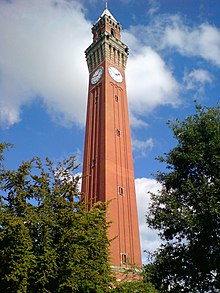
The campus has a wide diversity in architectural types and architects. "What makes Birmingham so exceptional among the Red Brick universities is the deployment of so many other major Modernist practices: only Oxford and Cambridge boast greater selections".[56]The Guild of Students original section was designed by Birmingham inter-war architectHolland Hobbisswho also designed theKing Edward's Schoolopposite. It was described as "Redbrick Tudorish" byNikolaus Pevsner.[57]
The statue on horseback fronting the entrance to the university andBarber Institute of Fine Artsis a 1722 statue ofGeorge Irescued from Dublin in 1937. This was saved by Bodkin, a director of the National Gallery of Ireland and first director of the Barber Institute. The statue was commissioned by theDublin Corporationfrom the Flemish sculptorJohn van Nost.[58]
Final negotiations for part of what is now the Vale were only completed in March 1947. By then, properties which would have their names used for halls of residences such as Wyddrington and Maple Bank were under discussion and more land was obtained from the Calthorpe estate in 1948 and 1949 providing the setting for the Vale.[59]Landscape architectMary Mitchelldesigned the layout of the campus and she included mature trees that were retained from the former gardens.[60]Construction on the Vale started in 1962 with the creation of a 3-acre (12,000 m2) artificial lake and the building of Ridge, High, Wyddrington and Lake Halls. The first, Ridge Hall, opened for 139 women in January 1964, with its counterpart High Hall admitting its first male residents the following October.[61]
1960s and modern expansion[edit]
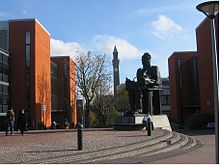
The university underwent a major expansion in the 1960s due to the production of a masterplan by Casson, Conder and Partners. The first of the major buildings to be constructed to a design by the firm was the Refectory and Staff House which was built in 1961 and 1962. The two buildings are connected by a bridge. The next major buildings to be constructed were the Wyddrington and Lake Halls and the Faculty of Commerce and Social Science, all completed in 1965. The Wyddrington and Lake Halls, on Edgbaston Park Road, were designed byH. T. Cadbury-Brownand contained three floors of student dwellings above a single floor of communal facilities.[citation needed]
The Faculty of Commerce and Social Science, now known as the Ashley Building, was designed by Howell, Killick, Partridge and Amis and is a long, curving two-storey block linked to a five-storeywhorl.The two-storey block follows the curve of the road, and has load-bearing brick cross walls. It is faced in specially-made concrete blocks. The spiral is faced with faceted pre-cast concrete cladding panels.[24]It wasstatutorily listedin 1993[62]and a refurbishment by Berman Guedes Stretton was completed in 2006.[63]
Chamberlain, Powell and Bon were commissioned to design the Physical Education Centre which was built in 1966. The main characteristic of the building is the roof of the changing rooms and small gymnasium which has hyperbolic paraboloid roof light shells and is completely paved in quarry tiles. The roof of the sports hall consists of eight conoidal 2½-inch thick sprayed concrete shells springing from 80-foot (24 m) long pre-stressed valley beams. On the south elevation, the roof is supported on raking pre-cast columns and reversed shells form acantileveredcanopy.[citation needed]
Also completed in 1966 was the Mining and Minerals Engineering and Physical Metallurgy Departments, which was designed byPhilip DowsonofArup Associates.This complex consisted of four similar three-storey blocks linked at the corners. The frame is of pre-cast reinforced concrete with columns in groups of four and the whole is planned as a tartan grid, allowing services to be carried vertically and horizontally so that at no point in a room are services more than ten feet away. The building received the 1966RIBAArchitecture Award for the West Midlands.[24]It wasstatutorily listedin 1993.[62]Taking the full five years from 1962 to 1967, Birmingham erected twelve buildings which each cost in excess of a quarter of a million pounds.[64]
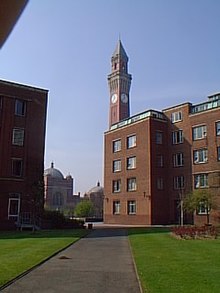
In 1967, Lucas House, a new hall of residence designed byThe John Madin Design Group,was completed, providing 150 study bedrooms. It was constructed in the garden of a large house. The Medical School was extended in 1967 to a design by Leonard J. Multon and Partners. The two-storey building was part of a complex which covers the southside ofMetchley Fort,a Roman fort. In 1968, the Institute for Education in the Department for Education was opened. This was another Casson, Conder and Partners-designed building. The complex consisted of a group of buildings centred around an eight-storey block, containing study offices, laboratories and teaching rooms. The building has a reinforced concrete frame which is exposed internally and the external walls are of silver-grey rustic bricks. The roofs of the lecture halls, penthouse and Child Study wing are covered in copper.[24]
Arup Associates returned in the 1960s to design the Arts and Commerce Building, better known as Muirhead Tower and houses the Institute of Local Government Studies. This was completed in 1969.[24]A£42 million refurbishment of the 16-storey tower was completed in 2009 and it now houses the Colleges of Social Sciences and the Cadbury Research Library, the new home for the university's Special Collections. The podium was remodeled around the existing Allardyce Nicol studio theatre, providing additional rehearsal spaces and changing and technical facilities. The ground floor lobby now incorporates aStarbuckscoffee shop.[65]The name, Muirhead Tower, came from that of the first philosophy professor of the universityJohn Henry Muirhead.[65][66][67]
Recently[when?]completed is a 450-seat concert hall, called the Bramall Music Building, which completes the redbrick semicircle of the Aston Webb building designed byGlenn Howells Architectswith venue design by Acoustic Dimensions. This auditorium, with its associated research, teaching and rehearsal facilities, houses the Department of Music.[68]In August 2011 the university announced that architectsLifschutz Davidson SandilandsandS&Pwere appointed to develop a new Indoor Sports Centre as part of a £175 million investment in the campus.[needs update][69]
Other features[edit]
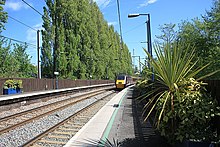
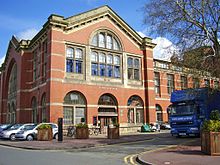
In 1978,University station,on theCross-City Line,was opened to serve the university and its hospital. It is the only university campus in mainland Britain with its own railway station.[citation needed]In 2021, construction began on a redeveloped facility adjacent to the existing structure as part of the West Midlands Rail Programme (WMRP).[70]The rebuilt station was completed and opened to the public in January 2024.[71]Nearby, the Steampipe Bridge, which was constructed in 2011, transports steam across the Cross-City Railway Line andWorcester & Birmingham Canalfrom the energy generation plant to the medical school as part of the university's sustainable energy strategy. Its laser-cut exterior is also a public art feature.[72]
Located within the Edgbaston site of the university is theWinterbourne Botanic Garden,a 24,000 square metre (258,000 square foot)EdwardianArts and Craftsstyle garden. The large statue in the foreground was a gift to the university by its sculptor Sir Edward Paolozzi – the sculpture is named 'Faraday', and has an excerpt from the poem 'The Dry Salvages' byT. S. Eliotaround its base.
The University of Birmingham operates theLapworth Museum of Geologyin the Aston Webb Building inEdgbaston.It is named afterCharles Lapworth,a geologist who worked at Mason Science College.
Since November 2007, the university has been holding afarmers' marketon the campus.[73]Birmingham is the first university in the country to have an accredited farmers' market.[74]
The considerable extent of the estate meant that by the end of the 1990s it was valued at £536 million.[75]
University of Birmingham marked its grand ending of Green Heart Project at the start of 2019.[76][77]
In 2021, the University opened a central-city meeting and conference site calledThe Exchangein the formerBirmingham Municipal BankinCentenary Square.[78]
Selly Oak campus[edit]
The university'sSelly Oakcampus is a short distance to the south of the main campus. It was the home of a federation of nine colleges, known asSelly Oak Colleges,mainly focused on theology, social work, and teacher training.[79]The Federation was for many years associated with the University of Birmingham. A new library, the Orchard Learning Resource Centre, was opened in 2001, shortly before the Federation ceased to exist. The OLRC is now one of Birmingham University's site libraries.[80]Among theSelly Oak Collegeswas Westhill College, (later the University of Birmingham, Westhill), which merged with the university's School of Education in 2001.[81]In the following years most of the remaining colleges closed, leaving two colleges which continue today,Woodbrooke College,a study and conference centre for theSociety of Friends,andFircroft College,a small adult education college with residential provision.Woodbrooke College'sCentre for Postgraduate Quaker Studies, established in 1998, works with the University of Birmingham to deliver research supervision for the degrees of MA by research and PhD.[82]
The Selly Oak campus is now home to the Department of Drama and Theatre Arts in the newly refurbishedSelly Oak CollegesOld Library and George Cadbury Hall 200-seat theatre.[83]The UKdaytime televisionshowDoctorsis filmed on this campus.[84]TheUniversity of Birmingham Schooloccupies a brand new, purpose-built building located on the university's Selly Oak campus.[85]TheUniversity of Birmingham Schoolis sponsored by the University of Birmingham and managed by an Academy Trust. TheUniversity of Birmingham Schoolopened in September 2015.[86]
Mason College and Queen's College campus[edit]

The Victorian neo-gothicMason CollegeBuilding in Birmingham city centre housed Birmingham University's Faculties of Arts and Law for over 50 years after the founding of the university in 1900. The Faculty of Arts building on the Edgbaston campus was not constructed until 1959–61. The Faculties of Arts and Law then moved to the Edgbaston campus.[87]The originalMason CollegeBuilding was demolished in 1962 as part of the redevelopment within the inner ring road.
The 1843 Gothic Revival building constructed opposite the Town Hall between Paradise Street (the main entrance) and Swallow Street served asQueen's College,one of the founder colleges of the university. In 1904 the building was given a new buff-coloured terracotta and brick front. The medical and scientific departments merged with Mason College in 1900 to form the University of Birmingham and sought new premises in Edgbaston. The theological department of Queen's College did not merge with Mason College, but later moved in 1923 to Somerset Road in Edgbaston, next to the University of Birmingham as theQueen's Foundation,maintaining a relationship with the University of Birmingham until a 2010 review. In the mid 1970s, the original Queen's College building was demolished, with the exception of the grade II listed façade.
Dubai Campus[edit]
The university also has an affiliatedDubaicampus established in 2017 at Dubai International Academic City (DIAC). They have since moved from the DIAC headquarters with the construction of a new campus in 2022 in the same area, inaugurated by the Dubai crown princeHamdan Bin Mohammed Al Maktoum.The campus boasts of having all faculty flown in or permanently staffed from the UK campus.[88]
Organisation and administration[edit]
Academic departments[edit]
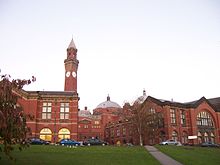

Birmingham has departments covering a wide range of subjects. On 1 August 2008, the university's system was restructured into five 'colleges', which are composed of numerous 'schools':
- Arts and Law(English, Drama and Creative Studies; History and Cultures; Languages, Cultures, Art History and Music; Birmingham Law School; Philosophy, Theology and Religion)
- Engineering and Physical Sciences(Chemistry; Chemical Engineering; Computer Science; Engineering (comprising the Departments of civil, Mechanical and Electrical, Electronic & Systems Engineering); Mathematics; Metallurgy and Materials; Physics and Astronomy)
- Life and Environmental Sciences(Biosciences; Geography, Earth and Environmental Sciences; Psychology; Sport and Exercise Sciences)
- Medical and Dental Sciences(Institute of Cancer and Genomic Sciences; Institute of Clinical Sciences; Institute of Inflammation and Ageing; Institute of Applied Health Research; Institute of Cardiovascular Science; Institute of Immunology and Immunotherapy; Institute of Metabolism and Systems Research; Institute of Microbiology and Infection).
- Social Sciences(Birmingham Business School;Education; Government and Society; Social Policy)
- Liberal Arts and Sciences
The university is home to a number of research centres and schools, including the Birmingham Business School, the oldest business school in England, theUniversity of Birmingham Medical School,the International Development Department, theInstitute of Local Government Studies,theCentre of West African Studies,the Centre for Russian and East European Studies, the Centre of Excellence for Research in Computational Intelligence and Applications and theShakespeare Institute.TheThird SectorResearch Centre was established in 2008,[89]and the Institute for Research intoSuperdiversitywas established in 2013.[90]Apart from traditional research and PhDs, under the department of Engineering and Physical Sciences, the university offers split-site PhD in Computer Science.[91]The university is also home to theBirmingham Solar Oscillations Network(BiSON) which consists of a network of six remote solar observatories monitoring low-degree solar oscillation modes. It is operated by the High Resolution Optical Spectroscopy group of the School of Physics and Astronomy, funded by theScience and Technology Facilities Council(STFC).[92]
International Development Department[edit]
The International Development Department (IDD) is a multi-disciplinary academic department focused onpoverty reductionthrough developing effective governance systems. The department is one of the leading UK centres for the postgraduate study ofinternational development.[93]The department has been described as being a "highly regarded, long-established specialist unit" with a "global reputation" byThe Independent.[94]
Off-campus establishments[edit]

A number of the university's centres, schools and institutes are located away from its two campuses in Edgbaston and Selly Oak:
- TheShakespeare Institute,inStratford-upon-Avon,which is a centre for postgraduate study dedicated to the study ofWilliam Shakespeareand theliteratureof theEnglish Renaissance.
- TheIronbridge Institute,inIronbridge,which offers postgraduate and professional development courses inheritage.
- The School of Dentistry (the UK's oldest dental school), in Birmingham City Centre.
- The Raymond Priestley Centre, nearConistonin theLake District,which is used foroutdoor pursuitsandfield work.[95]
There is also aMasonic Lodgethat has been associated with the university since 1938.[96]
University of Birmingham Observatory[edit]
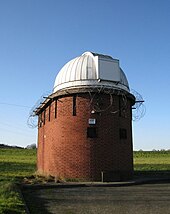
In the early 1980s, the University of Birmingham constructed an observatory next to the university playing fields, approximately 5 miles (8.0 km) south of the Edgbaston campus. The site was chosen because the night sky was ~100 times darker than the skies above campus. First light was on 8 December 1982, and the Observatory was officially opened by theAstronomer Royal,Francis Graham-Smith,on 13 June 1984.[97]The observatory was upgraded in 2013.
The Observatory is used primarily for undergraduate teaching.[98]It has two main instruments, a 16 "Cassegrain(working at f/19) and a 14 "MeadeLX200R (working at f/6.35). A third telescope is also present and is used exclusively for visual observations.
Members of the public are given chance to visit the Observatory at regularAstronomy in the Cityevents during the winter months.[99]These events include a talk on the night sky from a member of the university's studentAstronomical Society;a talk on current astrophysics research, such asexoplanets,galaxy clustersorgravitational-wave astronomy,[100]a question-and-answer session, and the chance to observing using telescopes both on campus and at the Observatory.
Branding[edit]
The original coat of arms was designed in 1900. It features a double headed lion (on the left) and a mermaid holding a mirror and comb (to the right). These symbols owe to the coat of arms of the institution's predecessor, Mason College.
In 2005 the university began rebranding itself. A simplified edition of the shield which had been introduced in the 1980s reverted to a detailed version based on how it appears on the university's original Royal Charter.
Academic profile[edit]
Libraries and collections[edit]
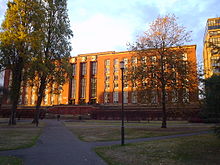
Library Services operates six libraries. They are the Barber Fine Art Library, Barnes Library, Main Library, Orchard Learning Resource Centre, Dental Library, and the Shakespeare Institute Library. Library Services also operates the Cadbury Research Library.[101]
The Shakespeare Institute's library is a major United Kingdom resource for the study of English Renaissance literature.[102]
The Cadbury Research Library is home to the University of Birmingham's historic collections of rare books, manuscripts, archives, photographs and associated artefacts. The collections, which have been built up over a period of 120 years consist of over 200,000 rare printed books including significantincunabula,as well as over 4 million unique archive and manuscript collections.[103]The Cadbury Research Library is responsible for directly supporting the university's research, learning and teaching agenda, along with supporting the national and international research community.
The Cadbury Research Library contains the Chamberlain collection of papers fromNeville Chamberlain,Joseph ChamberlainandAusten Chamberlain,the Avon Papers belonging toAnthony Edenwith material on theSuez Crisis,the Cadbury Papers relating to theCadburyfirm from 1900 to 1960, the Mingana Collection of Middle Eastern Manuscripts ofAlphonse Mingana,theNoël CowardCollection, the papers ofEdward Elgar,Oswald Mosley,andDavid Lodge,and the records of the EnglishYMCAand of theChurch Missionary Society.The Cadbury Research Library has recently taken in the complete archive of UKSave the Children.The Library holds important first editions such as De Humani Corporis (1543) by Versalius, the Complete Works (1616) of Ben Jonson, two copies of The Temple of Flora (1799-1807) by Robert Thornton and comprehensive collections of the works ofJoseph PriestleyandD H Lawrenceas well as many other significant works.
In 2015,a Quranic manuscriptin the Mingana Collection was identified as one of the oldest to have survived, having been written between 568 and 645.[104][105]
At the beginning of the 2016/17 academic year, a new main library opened on the Edgbaston campus and the old library has now been demolished as part of the plans to create a 'Green Heart' as per the original plans for the university whereby the clock tower would be visible from the North Gate.[106][107]The Harding Law Library was closed and renovated to become the university's Translation and Interpreting Suite.
Medicine[edit]
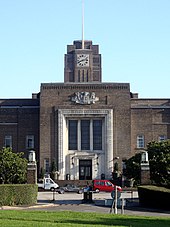
The University of Birmingham's medical school is one of the largest in Europe with well over 450 medical students being trained in each of the clinical years and over 1,000 teaching, research, technical and administrative staff[citation needed].The school has centres of excellence in cancer, pharmacy, immunology, cardiovascular disease, neuroscience and endocrinology, and is renowned nationally and internationally for its research and developments in these fields.[108][better source needed]The medical school has close links with theNHSand works closely with 15 teaching hospitals and 50 primary care training practices in theWest Midlands.
TheUniversity Hospital Birmingham NHS Foundation Trustis the main teaching hospital in the West Midlands. It has been given three stars for the past four consecutive years.[109]
Rankings and reputation[edit]
| National rankings | |
|---|---|
| Complete(2025)[110] | 12= |
| Guardian(2024)[111] | 37 |
| Times / Sunday Times(2024)[112] | 22 |
| Global rankings | |
| ARWU(2023)[113] | 151–200 |
| QS(2025)[114] | 80= |
| THE(2024)[115] | 101 |
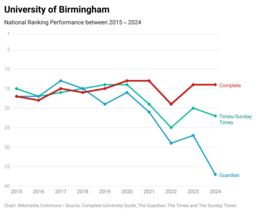
The 2022U.S. News & World Reportranks Birmingham 91st in the world.[116]In 2019, it is ranked 137th among the universities around the world bySCImago Institutions Rankings.[117]
In 2021 the Times Higher Education placed Birmingham 12th in the UK.[118]
In 2013, Birmingham was named 'Sunday Times University of the Year2014'.[119]The 2013QS World University Rankingsplaced Birmingham University at 10th in the UK and 62nd internationally. Birmingham was ranked 12th in the UK in the 2008Research Assessment Exercisewith 16 per cent of the university's research regarded as world-leading and 41 per cent as internationally excellent, with particular strengths in the fields of music, physics, biosciences, computer science, mechanical engineering, political science, international relations and law.[120][121][122]Course satisfaction was at 85% in 2011 which grew to 88% in 2012.[123]
In 2015 the Complete University Guide placed Birmingham 5th in the UK for graduate prospects.[124]
Data from theHigher Education Funding Council for England(HEFCE) placed the university amongst the twelve elite institutions who among them take more than half of the students with the highest A-level grades.[125]
Birmingham traditionally had a focus on science, engineering, commerce and coal mining, but has now expanded its provision. It hosted the firstCancer Research UKCentre,[126]and making notable contributions togravitational-wave astronomy,hosting the Institute of Gravitational Wave Astronomy.[127]
The School of Computer Science ranked 1st in the 2014 Guardian University Guide,[128]4th in the 2013 Sunday Times League Table and 6th in the 2014 Sunday Times League Table.[129]
The Department of Philosophy ranked 3rd in the 2017 Guardian University League Tables,[130]below theUniversity of Oxfordand above theUniversity of Cambridge,with the first being theUniversity of St Andrews.
The combined course of Computer Science and Information Systems, titled Computer Systems Engineering was ranked 4th in the 2016 Guardian University guide.[131]
The Department of Political Science and International Studies (POLSIS) ranked 4th in the UK and 22nd in the world in the Hix rankings of political science departments.[132]The sociology department also ranked 4th by The Guardian University guide. The Research Fortnight's University Power Ranking, based on quality and quantity of research activity, put the University of Birmingham 12th in the UK, leading the way across a broad range of disciplines including Primary Care, Cancer Studies, Psychology and Sport and Exercise Sciences.[133]The School of Physics and Astronomy also performed well in the rankings, being ranked 3rd in the 2012 Guardian University Guide[134]and 7th in The Complete University Guide 2012.[135]The School of Chemical Engineering is ranked second in the UK by the 2014 Guardian University Guide.[136]
Admissions[edit]
|
| Domicile[140]and Ethnicity[141] | Total | ||
|---|---|---|---|
| British White | 48% | ||
| British Ethnic Minorities[a] | 27% | ||
| International EU | 3% | ||
| International Non-EU | 22% | ||
| UndergraduateWidening ParticipationIndicators[142][143] | |||
| Female | 57% | ||
| Private School | 16% | ||
| Low Participation Areas[b] | 8% | ||
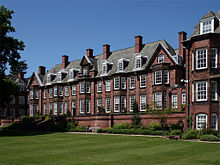
In terms of the averageUCAS pointsof entrants, Birmingham ranked 26th in Britain in 2021.[139]According to the 2017TimesandSunday TimesGood University Guide, approximately 20% of Birmingham's undergraduates come from independent schools.[144]In 2016, the university gave offers of admission to 79.2% of applicants, the 8th highest amongst theRussell Group.[145]In 2022, offers were given to 61.3% of undergraduate applicants, the 30th lowest offer rate across the country.[146]
In the 2016–17 academic year, the university had a domicile breakdown of 76:5:18 of UK:EU:non-EU students respectively, with a female to male ratio of 56:44.[147]50.3% ofinternational studentsenrolled at the institution are from China, the fourth highest proportion out of all mainstream universities in the UK.[148]
Birmingham Heroes[edit]
To highlight leading areas of research, the university has launched the Birmingham Heroes scheme. Academics who lead research that impacts on the lives of people regionally, nationally and globally can be nominated for selection.[149]Heroes include:
- Alberto Vecchioand Andreas Freise for their work as part of theLIGO Scientific Collaborationtowards thefirst observation of gravitational waves[150]
- Martin Freer,Toby Peters and Yulong Ding for their work on energy efficientcooling[151]
- Philip Newsome, Thomas Solomon and Patricia Lalor for tackling the silent killers,liver diseaseanddiabetes[152]
- James Arthur, Kristján Kristjánsson, Sandra Cooke and Tom Harrison for promoting character in education[153]
- Lisa Bortolotti, Ema Sullivan-Bissett and Michael Larkin for their work on how to break down thestigmaassociated withmental illness[154]
- Kate Thomas, Joe Alderman, Rima Dhillon and Shayan Ahmed for their research in and teaching oflife sciences[155]
- Pam Kearns, Charlie Craddock and Paul Moss forcancer research[156]
- Anna Phillips, Glyn Humphreys and Janet Lord who research healthyageing[157]
- Pierre Purseigle, Peter Gray and Bob Stone for using their historical knowledge to advise government organisations[158]
- Paul Bowen and Nick Green for research into newmaterialsto improveenergy generation[159]
- Lynne Macaskie, William Bloss and Jamie Lead for their study ofpollutants,particularlynanoscalepollutants[160]
- Paul Jackson, Scott Lucas and Stefan Wolff for their work helping with post-conflict and advice on the application ofaid[161]
- Hongming Xu, Clive Roberts and Roger Reed for work on sustainable transport[162]
- Moataz Attallah, Kiran Trehan and Tim Daffron for driving economic growth through improvingaerospace engineering,developing enterprise and pioneering industrial applications ofsynthetic biology[163]
Birmingham Fellows[edit]

The Birmingham Fellowship scheme was launched in 2011. The scheme encourages high potential early career researchers to establish themselves as rounded academics and continue pursuing their research interests. This scheme was the first of its kind, and has since been emulated in several otherRussell Groupuniversities across the UK.[164]Since 2014, the scheme has been divided intoBirmingham Research FellowshipsandBirmingham Teaching Fellowships. Birmingham Fellows are appointed to permanent academic posts (with two or three year probation periods), with five years protected time to develop their research.[165]
Birmingham Fellows are usually recruited at a lecturer or senior lecturer level. In the first period of the fellowship, emphasis is placed on the research aspect, publishing high quality academic outputs, developing a trajectory for their work and gaining external funding. However, development of teaching skills is encouraged.[165]Teaching and supervisory responsibilities, as well as administrative duties, then steadily increase to a normal lecturer's load in the Fellow's respective discipline by the fifth year of the fellowship. Birmingham Fellows are not expected to carry out academic administration during their term as Fellows, but will do once their posts turn into lectureships ('three-legged contract'). When accepted into the Birmingham Research Fellowship, Fellows receive a start-up package to develop or continue their research projects, an academic mentor and support for both research and teaching. All fellows are said to become part of the Birmingham Fellows Cohort, which provides them a university-wide network and an additional source of support and mentoring.[165]
International cooperation[edit]
In Germany the University of Birmingham cooperates with theGoethe University Frankfurt.Both cities are linked by a long-lasting partnership agreement.
Student life[edit]
Guild of Students[edit]
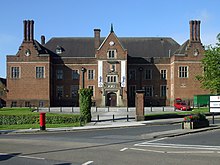
The University of Birmingham Guild of Students is the university'sstudent union.Originally the Guild of Undergraduates, the institution had its first foundations in the Mason Science College in the centre of Birmingham around 1876. The University of Birmingham itself formally received its Royal Charter in 1900 with the Guild of Students being provided for as a Student Representative Council.[166]It is not known for certain why the name 'Guild of Students' was chosen as opposed to 'Union of Students'; however, the Guild shares its name withLiverpool Guild of Students,another 'redbrick university'; both organisations subsequently founded theNational Union of Students.The Union Building, the Guild's bricks and mortar presence, was designed by the architectHolland W. Hobbiss.
The Guild's official purposes are to represent its members and provide a means of socialising, though societies and general amenities. The university provides the Guild with the Union Building effectively rent free as well as a block grant to support student services. The Guild also runs several bars, eateries, social spaces and social events.
The Guild supports a variety of student societies and volunteering projects, roughly around 220 at any one time. The Guild complements these societies and volunteering projects with professional staffed services, including its walk-in Advice and Representation Centre (ARC), Student Activities, Jobs/Skills/Volunteering, Student Mentors in halls, and Community Wardens aroundBournbrook.[167]The Guild of Students was where the student volunteering charityInterVolwas conceived and developed as a student-led volunteering project in the early 2000s; the project links students will local volunteering opportunities as well as placements with charitable partners overseas.[168][169]Another two of the Guild's long-standing societies are Student Advice and Nightline (previously Niteline), which both provide peer-to-peer welfare support. The Guild was one of the first universities in the United Kingdom to publish a campus newspaper,Redbrick,supported financially by the Guild of Students and advertising revenue.[170]
The Guild undertakes its representative function through its officer group, seven of whom are full-time, on sabbatical from their studies, and ten of whom are part-time and hold their positions whilst still studying. Elections are held yearly, conventionally February, for the following academic year. These officers have regular contact with the university's officer-holders and managers. In theory, the Guild's officers are directed and kept to account over their year in office by Guild Council, an 80-seat decision-making body. The Guild also supports the university "student reps" scheme, which aims to provide an effective channel of feedback from students on more of a departmental level.
Sport[edit]
This section'stone or style may not reflect theencyclopedic toneused on Wikipedia.(March 2021) |
This sectioncontains content that is written likean advertisement.(March 2021) |


The University of Birmingham opened the Sport and Fitness Centre in May 2017 providing facilities including gym, squash courts, 50m swimming pool, and climbing wall. The University has two international standard hockey pitches, completed in 2017,[171]flexible 3G pitches which can be used for 5-a-side and 11-a-side football, as well as netball and tennis courts, and a 400m athletics track at Edgbaston Park Road.[172]
As of the 2019 league, the university is ranked seventh in theBritish Universities and Colleges Sportleague table.[173]
University of Birmingham Sport provides a range of competitive and participation sports, for both the student and local community. Services include 180 fitness classes a week, 56 different sport clubs, including rowing, basketball, cricket, football, rugby union, netball, field hockey, ice hockey, American football, and triathlon. The wide selection has ensured the university has over 4,000 students participating in sport each year. The university also opened the Raymond Priestley Centre in 1981 on the shores of Coniston Water in the Lake District, offering students, staff and community alike to explore outdoor activities and learning in the area.
Sir Raymond Priestley, vice-chancellor of the university in 1938, and his Director of Sport A.D. Munrow, helped establish the first undergraduate courses in Physical Education in 1946, developed their sports facilities – starting with the gymnasium in 1939, and made participation in recreational sport compulsory for all new undergraduates from 1940 to 1968. Birmingham became the first UK university to offer a sports degree.
Students and alumni from the University of Birmingham have competed at Olympics, Paralympics and Commonwealth Games. In 2004, six graduates and one student competed in the2004 Athens Summer Olympics,and four alumni competed at the2008 Beijing Olympics,including cyclistPaul Manningwho won an Olympic Gold.[174]In 2012, Pamela Relph MBE was part of the rowing mixed coxed four that won Paralympic gold, and she successfully defended her title in Rio: the only current international para-rower to be a double Paralympic Champion.
In the 2018Commonwealth Gamesin Gold Coast, Australia, six students and eighteen alumni attended representing England, Scotland, Wales, and Guernsey, and competing in sports including hockey, 1500m, badminton, and cycling.[175]
The university hosted the Jamaican track and field team prior to the2012 London Olympics.The team, including the world's fastest man, Usain Bolt – who became the first man in history to defend his 100 metres and 200 metres titles at the Olympics – won team gold for the4 × 400 malong with Nesta Carter, Yohan Blake and Michael Frater. Shelly-Ann Fraser-Pryce won gold in the women's 100 metres. The team returned to the university in 2017 to prepare for London's Indoor Championships, staying in the Chamberlain Hall on the Vale Village, and using the newly established Sport & Fitness facilities and athletics track.
University of Birmingham Sport has since been host to a number of international teams; the Australian and South Africa teams ahead of the men's Rugby World Cup in 2015, the Jamaican, England and New Zealand netball teams before the Vitality Nations Cup in January 2020, and 19 nations for the individual competition at the World University Squash Championships in 2018.
Birmingham was selected as the host for the 2022 Commonwealth Games and the University was chosen as the venue for hockey and squash, due to the ability of existing facilities to host the games with only temporary structures needing to be constructed for seating, lighting, and broadcasting. The University was the largest athletes village during the games, hosting 3,500 athletes in Tennis Courts and the Vale, and the University was the official training venue for both swimming and athletics.[176]
University of Birmingham Sport also offers around 30 scholarships and bursaries to national and international students of exceptional athletic ability.[177]
Housing[edit]
The university provides housing for most first-year students, running a guarantee scheme for all those UK applicants who choose Birmingham as their firm UCAS choice. 90 per cent of university-provided housing is inhabited by first-year students.[178]
The university maintained gender-segregated halls until the beginning of the 1998-99 academic year when Lake and Wyddrington "halls" (treated as two different halls, despite being physically one building) were renamed as Shackleton Hall. Chamberlain Hall (Eden Tower), a seventeen-storey tower block, was originally known as High Hall, for male students, and the connected Ridge Hall (later renamed to the Hampton Wing), for female students. University House was decommissioned as accommodation to house the expanding Business School, while Mason Hall has been demolished and rebuilt, opening in 2008.[citation needed]In the summer of 2006, the university sold three of its most distant halls (Hunter Court, the Beeches and Queens Hospital Close) to private operators, while later in the year and during term, the university was forced urgently to decommission both the old Chamberlain Tower (High Hall) and also Manor House over fire safety inspection failures.[citation needed]The university has rebranded its halls offerings into three villages.[citation needed]
Vale Village[edit]
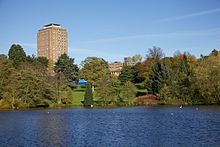
The Vale Village includes Chamberlain Hall, Shackleton, Maple Bank, Tennis Court, Elgar Court and Aitken residences. A sixth hall of residence, Mason Hall, re-opened in September 2008 following a complete rebuild. Approximately 2,700 students live in the village.[179]
Shackleton Hall (originally Lake Hall, for male students, and Wyddrington Hall, for female students) underwent an £11 million refurbishment and was re-opened in Autumn 2004. There are 72 flats housing a total of 350 students. The majority of the units consist of six to eight bedrooms, together with a small number of one, two, three or five bedroom studio/apartments.[180]The redevelopment was designed by Birmingham-based architect Patrick Nicholls while employed at Aedas, now a director of Glancy Nicholls Architects.[181]
Maple Bank was refurbished and opened in summer 2005. It consists of 87 five bedroom flats, housing 435 undergraduates.[182]
The Elgar Court residence consists of 40 six bedroom flats, housing a total of 236 students.[183]It opened in September 2003.
Tennis Court consists of 138 three, four, five and six bedroom flats and houses 697 students.[184]
The Aitken wing is a small complex consisting of 23 six and eight bedroom flats. It houses 147 students.[185]
Construction of the new Mason Hall commenced in June 2006 following complete demolition of the original 1960s structures. It was designed by Aedas Architects. The entire project is thought to have cost £36.75 million.[186]It has since been completed, with the first year of students moving in September 2008.
The new Chamberlain Tower and neighbouring low rise blocks opened in September 2015. Chamberlain is home to more than 700 first year students. It replaced the old 1964-built 18-storey (above ground level) High Hall (later renamed Eden Tower), for male students and low rise Ridge Hall (later renamed Hampton Wing) for female students, which closed in 2006. The 50-year-old Eden Tower was removed at the start of 2014. Previously known as High Hall, the tower and its associated low rise blocks were demolished after studies revealed it would be uneconomical to refurbish them and would not provide the quality of accommodation which the University of Birmingham desires for students.
The largest student-run event, theVale Festivalor 'ValeFest', is held annually on the Vale. The Festival celebrated its 10th event in 2014, raising £25,000 for charity. The 2019 event was headlined by The Hunna and Saint Raymond.
Pritchatts Park Village[edit]
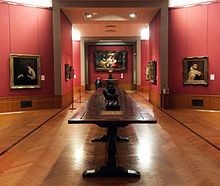
The Pritchatts Park Village houses over 700 undergraduate and postgraduate students. Halls include 'Ashcroft', 'The Spinney' and 'Oakley Court', as well as 'Pritchatts House' and the 'Pritchatts Road Houses'.[187]
The Spinney is a small complex of six houses and twelve smaller flats, housing 104 students in total.[188] Ashcroft consists of four purpose built blocks of flats and houses 198 students.[189]The four-storey Pritchatts House consists of 24 duplex units and houses 159 students.[190]Oakley Court consists of 21 individual purpose-built flats, ranging in size from five to thirteen bedrooms. Also included are 36 duplex units. A total of 213 students are housed in Oakley Court, made up of undergraduates.[191]Oakley Court was completed in 1993 at a cost of £2.9 million. It was designed by Birmingham-basedAssociated Architects.[192] Pritchatts Road is a group of four private houses that were converted into student residences. There is a maximum of 16 bedrooms per house.[193]
Selly Oak Village[edit]

Selly Oak Village consists of three residences in theSelly OakandBournbrookareas: Jarratt Hall, which is owned by the university, Douper Hall, and The Metalworks. As of 2008, the village had 637 bed spaces for students.[194]
Jarratt Hall is a large complex designed around a central courtyard and three landscaped areas. It housed 587 undergraduate students as of 2012.[195]Jarratt Hall did not accommodate postgraduate students until September 2013, due to ongoing refurbishment of kitchens and the heating system.[196]
The Manor House, Northfield[edit]

The University of Birmingham also own theNorthfield Manor House,having acquired the property from the Cadbury family in 1953. The property was used as The Manor House student accommodation until 2007, when the halls were found to be in need of restoration and refurbishment. In 2014, however, arsonists set a fire that gutted much of the property. The University of Birmingham has rebuilt and restored the property since then, and has converted much of the site into flats.[197]
Student Housing Co-operative accommodation[edit]
Birmingham Student Housing Co-operativewas opened in 2014 by students of the university to provide affordable self managed housing for its members. The co-operative manages a property on Pershore Road in Selly Oak.[citation needed]
Notable people[edit]
Academics[edit]


The faculty and staff members connected with the university include Nobel laureates SirNorman Haworth(Professor of Chemistry, 1925–1948),[198]SirPeter Medawar(Mason Professor of Zoology, 1947–1951),[29]John Robert Schrieffer(NSF Fellow at Birmingham, 1957),[199]David Thouless,Michael Kosterlitz,[200]and SirFraser Stoddart.[201]
Physicists includeJohn Henry Poynting,Freeman Dyson,SirOtto Frisch,SirRudolf Peierls,SirMarcus Oliphant,SirLeonard Huxley,Harry Boot,SirJohn Randall,andEdwin Ernest Salpeter.Chemists include SirWilliam A. Tilden.Mathematicians includeJonathan Bennett,Henry Daniels,Daniela Kühn,Deryk Osthus,Daniel PedoeandG. N. Watson.In music, faculty members include the composers SirEdward Elgarand SirGranville Bantock.Geologists includeCharles Lapworth,Frederick Shotton,and SirAlwyn Williams.In medicine, faculty members include SirMelville Arnottand SirBertram Windle.Biologists includeWilliam HillhouseandGeorge Stephen West,both Mason Professors of Botany.
Author and literary criticDavid Lodgetaught English from 1960 until 1987. Poet and playwrightLouis MacNeicewas a lecturer in classics 1930–1936. English novelist, critic, and man of lettersAnthony Burgesstaught in the extramural department (1946–50).[202]Richard Hoggartfounded theCentre for Contemporary Cultural Studies.SirAlan Walterswas Professor of Econometrics and Statistics (1951–68) and later became Chief Economic Adviser to Prime Minister Margaret Thatcher.Lord Zuckermanwas Professor of Anatomy 1946–1968 and also served as chief scientific adviser to the British government from 1964 to 1971.Lord King of Lothburywas a Professor in the Faculty of Commerce and later became Governor of theBank of England.SirWilliam James Ashleywas first Dean and the founder of the Birmingham Business School.
SirNathan Bodingtonwas Professor of Classics. SirMichael Lyonswas Professor of Public Policy from 2001 to 2006. SirKenneth Matherwas Professor of genetics (1948) and recipient of the 1964Darwin Medal.SirRichard Redmaynewas Professor of Mining and later became first Chief Inspector of Mines. The art historian SirNikolaus Pevsnerheld a research post at the university. SirEllis Waterhousewas Barber Professor of Fine Art (1952–1970).Lord Cadmantaught petroleum engineering and is credited with creating the course 'Petroleum Engineering'. The philosopher SirMichael Dummettheld an assistant lectureship at the university.Lord Borriewas a professor of law and dean of the faculty of law. SirCharles Raymond Beazleywas Professor of History. Prison reformerMargery Frywas first warden ofUniversity House.[203]
Vice-Chancellorsand Principals include SirOliver Lodge,Lord Hunter of Newington,SirCharles Grant Robertson,SirRaymond Priestley,and SirMichael Sterling.
Alumni[edit]



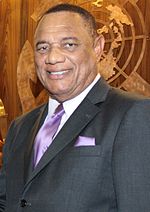

FourNobel Prize laureatesare Birmingham University alumni:Francis Aston,Maurice Wilkins,SirJohn Vane,and SirPaul Nurse.[198]In addition soil scientistPeter Bullockcontributed to the reports of theIPCC,which was awarded theNobel Peace Prize in 2007.[204]
The university's alumni in the sphere of British government and politics include: British Prime MinistersStanley BaldwinandNeville Chamberlain;[14]Chief Minister of GibraltarJoe Bossano;British cabinet minister and UN Under-Secretary-GeneralBaroness Amos;Cabinet MinistersJulian SmithandHilary Armstrong;British ministers of stateAnn Widdecombe,Richard Tracey,Derek Fatchett,andAnna Soubry;British High Commissioner to New Zealand and Ambassador to South Africa SirDavid Aubrey Scott;Governor of the Turks and Caicos IslandsNigel Dakin;Welsh Assembly Government ministerJane Davidson;and UN weapons inspectorDavid Kelly.
Birmingham's alumni in the field of government and politics in other countries include Prime Minister of St. LuciaKenny Anthony;Prime Minister of the BahamasPerry Christie;Singapore Minister of FinanceHu Tsu Tau Richard;Singapore Senior Minister of StateMatthias Yao;Minister of Defence of KenyaMohamed Yusuf Haji;Tanzanian ministerMark Mwandosya;Tongan ministerʻAna Taufeʻulungaki;Ethiopian cabinet ministerJunedin Sado;Deputy Prime Minister of MauritiusRashid Beebeejaun;Saudi ministerAbdulaziz bin Mohieddin Khoja;Foreign Minister of GambiaBala Garba Jahumpa;Ghanaian ministerJuliana Azumah-Mensah;Egyptian MinisterWilliam Selim Hanna;Nigerian ministerEmmanuel Chuka Osammor;Saint Lucian ministerAlvina Reynolds;Lebanese foreign ministerLucien Dahdah;Zambian PresidentHakainde Hichilemaand Zimbabwean ministersDavid KarimanziraandDidymus Mutasa.
Alumni in the world of business include: director of the Bank of EnglandLord Roll of Ipsden;CEO of J Sainsbury plcMike Coupe;Chairman of the Shell Transport and Trading Company plc SirJohn Jennings;automobile executive SirGeorge Turnbull;President of the Confederation of British Industry SirClive Thompson;CEO and chairman of BP SirPeter Walters;Chairman of British Aerospace SirAustin Pearce;mobile communications entrepreneurMo Ibrahim;fashion designer and retailerGeorge Davis;founder of Osborne Computer CorporationAdam Osborne;and chairman & CEO of Bass plc SirIan Prosser.
Alumni in the legal arena include Hong Kong Chief Justice of the Court of Final AppealGeoffrey Ma Tao-li;Hong Kong Judge of the Court of Final AppealRobert Tang;Justice of Appeal at the Court of Appeal in TanzaniaRobert Kisanga;Justice of the Supreme Court of BelizeMichelle Arana;Lord Justice of Appeal SirPhilip Otton;and High Court Judges DameNicola Davies,SirMichael Davies,SirHenry Globe,and DameLucy Theis.
Alumni in the armed forces include Chief of the General Staff General SirMike Jackson;and Director General of the Army Medical ServicesAlan Hawley.
Alumni in the sphere of religion include Metropolitan Archbishop and Primate of the Anglican Church in South East AsiaBolly Lapok;Anglican BishopsPaul Bayes,Alan Smith,Stephen Venner,Michael Langrish,andEber Priestley;Anglican Suffragan BishopsBrian CastleandColin Docker;Catholic ArchbishopKevin McDonald;and Catholic bishopPhilip Egan.
Alumni in the field of healthcare include: chair of the National Institute for Clinical ExcellenceDavid Haslam;DameHilda Lloyd,the first woman to be elected as president of the Royal College of Obstetricians and Gynaecologists; Chief Scientific Officer in the NHSSue Hill;Chief Dental Officer for EnglandBarry Cockcroft;and Chief Medical officer for England SirLiam Donaldson.
Alumni in the domain of engineering include: Chairman of the United Kingdom Atomic Energy Authority and of the Central Electricity Generating BoardLord Marshall of Goring;Chairman of British Aerospace SirAustin Pearce;Chief Engineer of the PWD Shaef in World War II SirFrancis McLean;and Director of Production at the Ministry of Munitions during World War I SirHenry Fowler.
Alumni in the creative industries include actorsMadeleine Carroll,Tim Curry,Tamsin Greig,Matthew Goode,Nigel Lindsay,Elliot Cowan,Geoffrey Hutchings,Judy Loe,Jane Wymark,Mariah Gale,Hadley Fraser,Elizabeth Henstridge,andNorman Painting;actors and comediansVictoria WoodandChris Addison;dancer/choreographer and co-creator of 'Riverdance'Jean Butler,social media influencer and YouTuberHannah Witton,children's author and scholarFawzia Gilani-Williams,authorPolly Ho-Yen,musiciansSimon Le BonofDuran DuranandChristine McVieofFleetwood Mac,and travel writerAlan Booth.
Alumni in academia include: University Vice-ChancellorsFrank Horton,SirRobert Howson Pickard,SirLouis Matheson,Derek Burke,SirAlex Jarratt,SirPhilip Baxter,Vincent Watts,P. B. Sharma,Berrick Saul,andWahid Omar;neurobiologist and Emeritus Professor at the University of Cambridge SirGabriel Horn,physicians SirAlexander Markham,SirGilbert Barling,Brian MacMahon,Aaron Valero,and SirArthur Thomson;neurologist SirMichael Owen;physicistsJohn Stewart Bell,SirAlan Cottrell,Lord Flowers,Harry Boot,Elliott H. Lieb(recipient of the 2003Henri Poincaré Prize),Stanley Mandelstam,Edwin Ernest Salpeter(recipient of the 1997Crafoord Prizein Astronomy), SirErnest William Titterton,andRaymond Wilson(recipient of the 2010Kavli Prizein Astrophysics); statisticianPeter McCullagh;chemist SirRobert Howson Pickard;biologists SirKenneth Murrayand LadyNoreen Murray;zoologistsDesmond MorrisandKarl Shuker;behavioural neuroscientistBarry Everitt;palaeontologistHarry B. Whittington;computer scientistMike Cowlishaw;Women's writing academicLorna Sage;philosopherJohn Lewis;economist and historianHoma Katouzian;theologian and biochemistArthur Peacocke;labour economistDavid Blanchflower;Professor of Social Policy at the London School of Economics SirJohn Hills;geographerGeoffrey J.D. Hewings;Professor of Geology and ninth President of Cornell UniversityFrank H. T. Rhodes;Government Chief Scientific Adviser SirAlan Cottrell;and former astronautRodolfo Neri Vela.
Alumni in the world of sport are many. They includeLisa Clayton,the first woman to sail the globe single-handed; 400 metres runnerAllison Curbishley,who won silver at the1998 Commonwealth Games;team pursuitcyclistPaul Manning,who won bronze, silver and gold at the Olympics of 2004, 2008 and 2012; sports scholarIzzy Christiansen,who played football for Birmingham City, Everton and Manchester City before her call up to the senior England squad; Warwickshire and England cricketerJim Troughton;andAdam Pengillywho competed as a skeleton racer at the2006and2010 Winter Olympicsand was elected to theInternational Olympic Committee Athletes' Commissionin 2010.[205]
TriathleteChrissie WellingtonandRachel Joycewon the ITU Long Distance World Championship in 2008 and 2011, and Chrissie holds the four fastest times in the World Ironman competition. She received an OBE in 2009, and the current world-class gym at the Sport & Fitness club on campus is named in her honour.
Whilst still studying at the university, studentLily Owsleyscored the field hockey gold medal-winning goal at the2016 Rio Olympicswith the help of teammate and fellow UoB graduateSophie Bray.
Middle-distance athleteHannah Englandwon the World Championship 1500m silver in 2011[206]and after retiring from athletics officially in 2019, worked alongside fellow athlete and husband Luke Gunn in the Sport department at the university.[207]
In recent years, Birmingham has seen scholars such as athletesJonny Davies,2020 British indoor champion over 3000m; Sarah McDonald, a former 1500m British Champion, and Mari Smith, the current British indoor silver medallist over 800m pass through the doors. Fran Williams, senior England netballer player, won Bronze with the England Roses at the Vitality Netball World Cup in Liverpool in 2019, the youngest player on the squad at 22 years old, and Laura Keates, England international rugby player, who was part of the 2014 World Cup-winning squad.[citation needed]
Barbara Slater, daughter of Wolverhampton Wanderer's legend and UoB's Director of Sport in 1972 Bill Slater, became Director of BBC Sport from 2009, and was the first woman to hold this title. She led the broadcast of the London 2012 Olympics – the biggest television event in British broadcasting history. Former Manchester United Chief Executive David Gill learned the ropes of financing at Birmingham, studying Industrial, Economic and Business Studies in 1978; sports commentator Simon Brotherton developed his career whilst studying at UoB, and Sir Patrick Head, founder of the Williams team which dominated Formula One in the 1990s, studied Mechanical Engineering.[citation needed]
Across disciplines,John Crabtree,who graduated in law in 1972, achieved success as a lawyer and businessman, was awarded the OBE for his charity work, and served asHigh Sheriff of the West MidlandsandLord Lieutenant of the West Midlands,and as chair of the2022 Birmingham Commonwealth GamesOrganising Committee.[208]
See also[edit]
- Armorial of UK universities
- List of modern universities in Europe (1801–1945)
- List of universities in the United Kingdom
References[edit]
- Notes
- ^Ives et al. 2000, p. 238.
- ^abc"Mason College".Birmingham University. Archived fromthe originalon 25 December 2018.Retrieved9 October2014.
- ^abIves et al. 2000, p. 12.
- ^abc"Financial Statements for the Year to 31 July 2023"(PDF).University of Birmingham. p. 55.Retrieved15 December2023.
- ^"Lord Bilimoria installed as Chancellor of the University of Birmingham".University of Birmingham. 18 July 2014.Retrieved8 August2014.
- ^"Who's working in HE?".www.hesa.ac.uk.
- ^abc"Where do HE students study? | HESA".www.hesa.ac.uk.
- ^Curtis, Polly (29 July 2005)."Birmingham University houses tornado victims".The Guardian.London.Retrieved28 March2010.
- ^Bawden, Anna (11 February 2005)."Muslim students threaten to sue Birmingham University".The Guardian.London.Retrieved28 March2010.
- ^Whyte, William (16 January 2015).Redbrick: A Social and Architectural History of Britain's Civic Universities.ISBN978-0-19-102522-8.
- ^University guide 2014: University of Birmingham,The Guardian,8 June 2008. Retrieved 11 June 2010.
- ^"REF 2021: Golden triangle looks set to lose funding share".Times Higher Education.12 May 2022.Retrieved15 May2022.
- ^ab"25 tallest clock towers/government structures/palaces"(PDF).Council on Tall Buildings and Urban Habitat. January 2008. Archived fromthe original(PDF)on 30 October 2008.Retrieved9 August2008.
- ^abK. Feiling,The Life of Neville Chamberlain(London, 1970), 11–12.
- ^"Our Nobel Prize winners".University of Birmingham. Archived fromthe originalon 9 August 2018.Retrieved5 October2016.
- ^"History of the University of Birmingham Medical School, 1825 – 2001".University of Birmingham.
- ^Gosden, Peter. "From County College To Civic University, Leeds, 1904",Northern History42.2 (2005): 317-328.Academic Search Premier,Web. 12 November 2014.
- ^"A Mermaid's Tale: the origins of the University's Crest".Research and Cultural Collections.University of Birmingham.Retrieved28 April2021.
- ^Keith Anderton, slevenotes,Bantock: Hebridean Symphony,Naxos 8.555473, 1989.
- ^"Cadbury Research Library – Special Collections".University of Birmingham.
- ^ab"Our Impact"(PDF).Archived fromthe original(PDF)on 11 September 2014.Retrieved18 October2014.
- ^McNair, Philip (January 1977). "Linetta de Castelvecchio Richardson".Italian Studies.32(1). The Society for Italian Studies: 1–3.doi:10.1179/its.1977.32.1.1.
- ^Taylor, Sara."Linetta Richardson (1880–1975)".Dumbarton Oaks.Retrieved4 February2022.
- ^abcdeHickman, Douglas (1970).Birmingham.Studio Vista Limited.
- ^Ives et al. 2000, p. 342.
- ^Ives et al. 2000, p. 343.
- ^"Norman Haworth – Biographical".Nobelprize.org.Retrieved15 August2014.
- ^Brown, Laurie M.; Dresden, Max; Hoddeson, Lillian (1989).Pions to Quarks: Particle Physics in the 1950s: Based on a Fermilab Symposium.Cambridge University Press. pp. 167–9.ISBN0-521-30984-0.
- ^ab"Peter Medawar – Biographical".Nobelprize.org.Retrieved15 July2014.
- ^Harris, Tillie (22 March 2001)."Aston pulls out of merger talks with Birmingham".The Guardian.
- ^"University of Birmingham to host final Prime Ministerial Debate".University of Birmingham. 29 April 2010.Retrieved29 April2010.
- ^"Battleground ready for final prime-ministerial debate".BBC News. 29 April 2010.Retrieved29 April2010.
- ^"Students face a scramble for university places".BBC News. 9 August 2010.
- ^"Jamaica's 2012 Olympics team plan Birmingham base".BBC News. 21 February 2010.Retrieved29 April2010.
- ^"Sports & Fitness – University of Birmingham".birmingham.ac.uk.Retrieved23 May2018.
- ^"Green Heart FAQs".intranet.birmingham.ac.uk.Retrieved23 May2018.
- ^Newman, Melanie (12 November 2009)."Poor staff relations threaten Birmingham's sociology department".Times Higher Education.Retrieved29 April2010.
- ^"Investigating UK Universities through Freedom of Information".AcademicFOI.Com.
- ^"Early day motion 2484 – EDWARD BAUER, THE RIGHT TO PROTEST AND FREEDOM OF SPEECH – UK Parliament".Parliament of the United Kingdom.
- ^"Activism on campus".University of Birmingham.
- ^"High Court Order"(PDF).Retrieved16 August2013.
- ^[1][dead link]
- ^"Activism on campus".University of Birmingham. Archived fromthe originalon 11 July 2012.Retrieved25 November2013.
- ^Malik, Shiv (11 December 2011)."Birmingham University protest ban attacked as 'aggressive and censorious'".The Guardian.London.
- ^"Birmingham University refused to look into student's off-campus rape claim".The Guardian.18 November 2019.Retrieved24 November2019.
- ^"LGBTQ+ conversion therapy: University of Birmingham apologises".BBC News. 8 June 2022.Retrieved9 June2022.
- ^‘Conversion Therapy’ and the University of Birmingham, c.1966-1983(PDF),University of Birmingham,June 2022,WikidataQ112286535
- ^Crosby, Travis L. (2011).Joseph Chamberlain: A Most Radical Imperialist.I.B.Tauris. p. 236.ISBN9781848857537.Retrieved8 October2018.
- ^Burke, Edmund (1900).The Annual Register.Rivingtons. p. 27.ISBN1-60030-829-5.
- ^The Carnegie CommitteeArchived17 July 2011 at theWayback Machine,Cornell Alumni News,II(10), 29 November 1899, p. 6.
- ^Ray Smallman,A hundred years of distinction,BUMS centenary lecture, p. 5.
- ^Stephens, W.B. (1964)."A History of the County of Warwick: Volume 7".London: Oxford University Press. pp. 43–57.
- ^"Britain's tallest 100 buildings by height".Skyscraper News.Retrieved9 August2008.
- ^"Campus tour booklet"(PDF).University of Birmingham. Archived fromthe original(PDF)on 2 September 2009.Retrieved9 August2008.
- ^"Heritage trail: Joseph Chamberlain Memorial Clock Tower, completed 1909".University of Birmingham. Archived fromthe originalon 16 July 2011.Retrieved14 July2009.
- ^Foster, 2005, pp. 242–3.
- ^Braithwaite, 1987, p. 20.
- ^Ives et al. 2000, p. 230; Rupert Gunnis,Dictionary of British Sculptors 1660–1851(1968 revised edition), p.281 identifies it as a 1717 work forEssex Bridge, Dublin.
- ^Ives et al. 2000, p. 304.
- ^"THE VALE, EDGBASTON, Birmingham – 1001483 | Historic England".historicengland.org.uk.Retrieved14 April2021.
- ^Ives et al. 2000, p. 338.
- ^ab"Signalling the Sixties: 1960s Architecture in Birmingham".West Midlands: Birmingham.gov.uk. 13 June 2009. Archived fromthe originalon 21 August 2010.Retrieved29 April2010.
- ^"University of Birmingham: Faculty of Commerce and Social Science".Berman Guedes Stretton. Archived fromthe originalon 6 May 2011.Retrieved8 November2009.
- ^Ives et al. 2000, p. 336.
- ^abReisz, Matthew (24 September 2009)."Original features".Times Higher Education.Retrieved8 November2009.
- ^Takagi, Dr R."Muirhead Tower of the University of Birmingham".Takagi-ryo.ac.Retrieved29 April2010.
- ^"Muirhead Tower, Birmingham"(PDF).Archived fromthe original(PDF)on 27 March 2009.Retrieved29 April2010.
- ^"New Concert Hall for Birmingham to Open in 2012 on University Campus".Archived fromthe originalon 10 August 2011.Retrieved19 May2010.
- ^"University proposes £175m transformation of historic Edgbaston campus".University of Birmingham. 9 August 2011.
- ^"University Station".Transport for West Midlands.Archived fromthe originalon 23 May 2021.
- ^"New University Station buildings to open their doors this Sunday".West Midlands Rail Executive.Retrieved16 April2024.
- ^Rogers, Joseph (2019).Britain's Greatest Bridges.Amberley Publishing.ISBN978-1445684413.OCLC1053569340.
- ^"University Farmers' Market".University of Birmingham. 23 January 2008. Archived fromthe originalon 17 February 2008.Retrieved18 April2008.
- ^"Walnuts, Wine and Winterbourne Honey at First University Farmers' Market".University of Birmingham. 24 October 2007. Archived fromthe originalon 10 January 2008.Retrieved18 April2008.
- ^Ives, E. (2000). The First Civic University: Birmingham, 1880–1980 – An Introductory History. Birmingham: University of Birmingham Press.
- ^"University's Green Heart campus project completes | TheBusinessDesk.com".West Midlands.21 January 2019.Retrieved22 January2019.
- ^"Green Heart – University of Birmingham".birmingham.ac.uk.Retrieved22 January2019.
- ^Young, Graham (17 September 2021)."Dazzling first look inside The Exchange and café on Broad Street".BirminghamLive.
- ^"Hello/Goodbye!".hellogoodbyesellyoak.blogspot.co.uk.
- ^"Orchard Learning Resource Centre".University of Birmingham.
- ^"Former church college in merger talks with Birmingham University".Times Higher Education.20 April 2001.
- ^"Postgraduate Quaker Studies · Courses & Learning".Woodbrooke Quaker Study Centre. Archived fromthe originalon 21 December 2014.Retrieved21 December2014.
- ^"Archived copy"(PDF).Archived fromthe original(PDF)on 22 December 2014.Retrieved22 December2014.
{{cite web}}:CS1 maint: archived copy as title (link) - ^"BBC Birmingham Television Drama Village".BBC Birmingham.Retrieved24 April2008.
- ^"Our Building".bham.ac.uk.Archived fromthe originalon 21 December 2014.
- ^"About our School".bham.ac.uk.Archived fromthe originalon 21 December 2014.
- ^"Campus Construction photographs volume 1, 1950s-1963".Flickr.28 February 2013.
- ^"University of Birmingham Dubai - A leading global university".University of Birmingham.Retrieved18 June2023.
- ^University of Birmingham,Third Sector Research Centre: About us,accessed 26 April 2024
- ^Elkes, Neil (14 June 2013)."Superdiversity represents real opportunity for Birmingham".
- ^"PhD in Computer Science".University of Birmingham. 2015.Retrieved17 February2015.
- ^"High-Resolution Optical Spectroscopy – University of Birmingham".bison.ph.bham.ac.uk.Archived fromthe originalon 8 September 2015.
- ^"Department profile: University of Birmingham, School of Government & Society".Prospects. Archived fromthe originalon 18 July 2012.Retrieved25 August2010.
- ^"Birmingham University, School of Public Policy".The Independent.21 December 2008.Retrieved25 August2010.
- ^"Raymond Priestley Centre".bham.ac.uk.15 May 2014. Archived fromthe originalon 21 December 2014.
- ^"University of Birmingham Lodge Home Page".Uobmasoniclodge.org.uk. 30 August 2012.
- ^"Observatory: History".Astrophysics & Space Research Group.University of Birmingham.Retrieved29 November2015.
- ^"Observatory".Astrophysics & Space Research Group.University of Birmingham.Retrieved29 November2015.
- ^"Observatory: Astronomy in the City".Astrophysics & Space Research Group.University of Birmingham.Retrieved29 November2015.
- ^"Astronomy in the City".Gravitational Wave Group.University of Birmingham.Retrieved29 November2015.
- ^"Libraries and opening hours: opening hours".University of Birmingham.Retrieved21 April2021.
- ^"Shakespeare Institute Library".University of Birmingham.
- ^"University of Birmingham: Special Collections".Special-coll.bham.ac.uk.Retrieved29 April2010.
- ^"Birmingham Qur'an manuscript dated among the oldest in the world".University of Birmingham. 22 July 2015.Retrieved22 July2015.
- ^"'Oldest' Koran fragments found in Birmingham University ".BBC. 22 July 2015.Retrieved22 July2015.
- ^"New Library".University of Birmingham. Archived fromthe originalon 7 February 2013.
- ^"New Library Blog".University of Birmingham.
- ^"Welcome to the School of Medicine".University of Birmingham.Retrieved6 March2008.
- ^"Trust profile".University Hospital Birmingham NHS Foundation. Archived fromthe originalon 7 March 2008.Retrieved6 March2008.
- ^"Complete University Guide 2025".The Complete University Guide. 14 May 2024.
- ^"Guardian University Guide 2024".The Guardian.9 September 2023.
- ^"Good University Guide 2024".The Times.15 September 2023.
- ^"Academic Ranking of World Universities 2023".Shanghai Ranking Consultancy. 15 August 2023.
- ^"QS World University Rankings 2025".Quacquarelli Symonds Ltd. 4 June 2024.
- ^"THE World University Rankings 2024".Times Higher Education. 28 September 2023.
- ^"Search U.S. News Best Global Universities".U.S. News & World Report.Retrieved3 February2022.
- ^"SCImago Institutions Rankings – Higher Education – All Regions and Countries – 2019 – Overall Rank".scimagoir.com.
- ^"Best universities in the UK 2021".Times Higher Education.26 September 2018.Retrieved1 February2019.
- ^"Bold Birmingham wins our top university award".Times Higher Education.22 September 2013. Archived fromthe originalon 25 November 2013.
- ^"Research Assessment Exercise 2008 – Research – University of Birmingham".Research.bham.ac.uk. Archived fromthe originalon 6 April 2009.Retrieved29 April2010.
- ^"Research Fortnight's RAE 2008 Power table".Product.researchresearch.com.Retrieved29 April2010.[dead link]
- ^Asthana, Anushka (1 June 2009)."Profile: University of Birmingham".The Times.London.Retrieved11 November2009.
- ^"NSS Data 2012".HEFCE. 20 June 2013. Archived fromthe originalon 3 August 2013.Retrieved16 August2013.
- ^"The Complete University Guide (London)".5 May 2015.Retrieved19 May2015.
- ^Paton, Graeme (13 July 2011)."Top students concentrated in just 12 elite universities".The Daily Telegraph.London. Archived fromthe originalon 13 July 2011.Retrieved12 August2011.
- ^"Birmingham Cancer Research UK Centre".Cancer Research UK. Archived fromthe originalon 4 May 2011.Retrieved30 September2009.
- ^"University of Birmingham announces £6m for UK's first Institute of Gravitational Wave Astronomy".University of Birmingham.Retrieved4 October2016.
- ^"The Guardian (London)".4 June 2013.Retrieved8 July2013.
- ^"Sunday Times University Guide 2013: Computer Science".Sunday Times League Table. October 2012.Retrieved1 October2012.
- ^"The Guardian (London)".Retrieved25 May2016.
- ^"The Guardian (London)".26 May 2015.Retrieved27 May2015.
- ^Simon Hix,A global ranking of political science departmentsArchived21 December 2004 at theWayback Machine,Political Studies Review2(3), pp. 293–313.
- ^"University of Birmingham website – Research Fortnight".Research.bham.ac.uk. Archived fromthe originalon 8 February 2009.Retrieved29 April2010.
- ^"Guardian University Guide 2012 – Physics".The Guardian.London. 17 May 2011.Retrieved12 June2011.
- ^"The University of Birmingham website – Our Rankings".The Complete University Guide. Archived fromthe originalon 11 July 2012.Retrieved12 June2011.
- ^"Guardian University Guide 2014 – Chemical Engineering".The Guardian.London. 4 June 2013.Retrieved4 February2014.
- ^ab"UCAS Undergraduate Sector-Level End of Cycle Data Resources 2023".ucas.com.UCAS. December 2023. Show me... Domicile by Provider.Retrieved30 April2024.
- ^"2023 entry UCAS Undergraduate reports by sex, area background, and ethnic group".UCAS.30 April 2024.Retrieved30 April2024.
- ^ab"University League Tables entry standards 2024".The Complete University Guide.
- ^"Where do HE students study?: Students by HE provider".HESA.HE student enrolments by HE provider.Retrieved8 February2023.
- ^"Who's studying in HE?: Personal characteristics".HESA. 31 January 2023.Retrieved8 February2023.
- ^"Widening participation: UK Performance Indicators: Table T2a - Participation of under-represented groups in higher education".Higher Education Statistics Authority.hesa.ac.uk.Retrieved8 February2023.
- ^"Good University Guide: Social Inclusion Ranking".The Times.16 September 2022.
- ^"The Times and Sunday Times Good University Guide 2017".The Good University Guide.London. Archived fromthe originalon 29 November 2022.Retrieved16 August2016.(subscription required)
- ^Gurney-Read, Josie (19 October 2016)."Which elite universities have the highest offer rates".The Telegraph.Retrieved21 October2016.
- ^"Cambridge to scrap 'unjust' state school targets".The Telegraph. Archived fromthe originalon 31 March 2024.Retrieved11 March2024.
- ^"Where do HE students study?".hesa.ac.uk.Higher Education Statistics Authority.Retrieved9 February2018.
- ^Jack, Patrick (18 May 2023)."OfS writes to 23 institutions over 'high levels' of Chinese students".Times Higher Education.
- ^"Birmingham Heroes".Research.University of Birmingham.Retrieved14 February2016.
- ^"Gravitational Waves".Heroes.University of Birmingham.Retrieved14 February2016.
- ^"Energy crisis".Heroes.University of Birmingham.Retrieved14 February2016.
- ^"Silent killers".Heroes.University of Birmingham.Retrieved14 February2016.
- ^"Character matters".Heroes.University of Birmingham.Retrieved14 February2016.
- ^"Mental illness".Heroes.University of Birmingham.Retrieved14 February2016.
- ^"Medical heroes".Heroes.University of Birmingham.
- ^"Tackling cancer".Previous heroes.University of Birmingham.Retrieved14 February2016.
- ^"Healthy ageing".Previous heroes.University of Birmingham.Retrieved14 February2016.
- ^"Learning lessons from the past".Previous heroes.University of Birmingham.Retrieved14 February2016.
- ^"Revolutionising energy production".Previous heroes.University of Birmingham.Retrieved14 February2016.
- ^"Environmental pollutants".Previous heroes.University of Birmingham.Retrieved14 February2016.
- ^"Preventing and resolving conflict".Previous heroes.University of Birmingham.
- ^"Sustainable transport".Previous Heroes.University of Birmingham.Retrieved14 February2016.
- ^"Driving economic growth".Previous heroes.University of Birmingham.Retrieved14 February2016.
- ^"Birmingham University Alumni"(PDF).Retrieved22 January2015.
- ^abc"Birmingham Fellowships".Archived fromthe originalon 21 October 2014.Retrieved22 January2015.
- ^(Cheesewright 1975,p. 35)
- ^"Community Wardens".Guild of Students.Archived fromthe originalon 7 May 2013.Retrieved25 August2007.
- ^"University of Birmingham Buzz Magazine. Details of InterVol set-up by volunteers including Tamzin Kensett, page 2. Retrieved 29 May 2010"(PDF).Archived fromthe original(PDF)on 16 July 2011.Retrieved25 June2010.
- ^"About".InterVol.29 January 2017.Retrieved29 September2023.
- ^"Guild of Students Membership Handbook 2007–08"(PDF).University of Birmingham Guild of Students. Archived fromthe original(PDF)on 30 October 2008.Retrieved6 July2008.
- ^"University of Birmingham Hockey and Squash Centre".Commonwealth Games - Birmingham 2022.Retrieved16 September2022.
- ^"Outdoor Sport".University of Birmingham Sport & Fitness.Retrieved16 September2022.
- ^"BUCS Points – BUCScore".bucscore.bucs.org.uk.Retrieved5 October2021.
- ^"A chance to meet the University of Birmingham's Olympic heroes".University of Birmingham.Archived fromthe originalon 11 June 2021.Retrieved11 June2021.
- ^"University of Birmingham students and alumni selected for Gold Coast Commonwealth Games".University of Birmingham.Retrieved16 September2022.
- ^"University of Birmingham and Birmingham 2022 Commonwealth Games".University of Birmingham.Retrieved16 September2022.
- ^"Sport Scholarships | UoB Sport & Fitness".Sport and Fitness Birmingham.Retrieved5 October2021.
- ^Rich, Johnny (2005).The Push Guide to Which University 2006.Nelson Thornes.ISBN0-7487-9489-1.
- ^"Student accommodation: Vale Village".University of Birmingham. Archived fromthe originalon 9 January 2015.Retrieved19 November2013.
- ^"Student accommodation: Shackleton".University of Birmingham.Retrieved10 February2008.
- ^"Glancy Nicholls Architects".Glancy Nicholls Architects.Retrieved5 May2008.
- ^"Student accommodation: Maple Bank".University of Birmingham.Retrieved10 February2008.
- ^"Student accommodation: Elgar Court".University of Birmingham.Retrieved10 February2008.
- ^"Student accommodation: Tennis Court".University of Birmingham.Retrieved10 February2008.
- ^"Student accommodation: Aitken".University of Birmingham.Retrieved10 February2008.
- ^Robinson, Liz."Mason Hall Redevelopment".The Estates Office (University of Birmingham).Retrieved8 March2008.
- ^"Student accommodation: Pritchatts Park".University of Birmingham.Retrieved8 August2008.
- ^"Student accommodation: The Spinney".University of Birmingham.Retrieved10 February2008.
- ^"Student accommodation: Ashcroft".University of Birmingham.Retrieved10 February2008.
- ^"Student accommodation: Pritchatts House".University of Birmingham.Retrieved10 February2008.
- ^"Student accommodation: Oakley Court".University of Birmingham.Retrieved10 February2008.
- ^"Oakley Court, Pritchatts Road"(PDF).Associated Architects. Archived fromthe original(PDF)on 25 June 2008.Retrieved5 May2008.
- ^"Student accommodation: Pritchatts Road".University of Birmingham.Retrieved10 February2008.
- ^"Student accommodation: Selly Oak Village".University of Birmingham.Retrieved10 February2008.
- ^"Student accommodation: Jarratt Hall".University of Birmingham. Archived fromthe originalon 7 February 2013.Retrieved27 November2012.
- ^"Selly Oak Village – University of Birmingham".University of Birmingham. Archived fromthe originalon 21 May 2013.Retrieved7 April2013.
- ^"Historic Birmingham manor house to be rebuilt after arson attack".9 October 2016.
- ^ab"University of Birmingham Nobel Prize Winners".bhamalumni.org. Archived fromthe originalon 3 March 2012.Retrieved24 May2010.
- ^"J. Robert Schrieffer".The American Institute of Physics. Archived fromthe originalon 21 October 2013.Retrieved23 August2013.
- ^"Two former Birmingham scientists awarded Nobel Prize for Physics".University of Birmingham.Retrieved5 October2016.
- ^"Former University of Birmingham professor awarded 2016 Nobel Prize for Chemistry".University of Birmingham.Retrieved5 October2016.
- ^"Anthony Burgess".Encyclopædia Britannica.
- ^"Archived copy"(PDF).Archived fromthe original(PDF)on 6 October 2014.Retrieved15 March2015.
{{cite web}}:CS1 maint: archived copy as title (link) - ^Hallett, Stephen (1 July 2008)."Obituary:Peter Bullock".The Guardian.London.Retrieved14 December2012.
- ^"Adam Pengilly".teamgb.com.Retrieved11 June2021.
- ^"Hannah England's finish earns silver at World Athletics Championships".The Guardian.1 September 2011.Retrieved11 June2021.
- ^"Gunn Shares Insight into British Champs Coaching Success".British Athletics.
- ^"Crabtree, John Rawcliffe Airey, (born 5 Aug. 1949), Lord-Lieutenant of West Midlands, since 2017".Who's Who & Who Was Who.Retrieved29 May2022.
- Bibliography
- Foster, A. (2005).Birmingham (Pevsner Architectural Guides).London: Yale University Press.ISBN0-300-10731-5.
- Ives, Eric William; Schwarz, L. D.; Drummond, Diane K. (2000).The First Civic University: Birmingham 1880-1980 An Introductory History.Birmingham, UK: University of Birmingham Press.ISBN1-902459-07-5.
- The University of Birmingham Yearbook 2002–2003.
- Cheesewright, M. (1975).Mirror to a Mermaid.Birmingham: The University of Birmingham Press.ISBN0-7044-0130-4.
- Braithwaite, L. (1987).University of Birmingham Architectural Trail.Birmingham: The University of Birmingham Press.ISBN0-7044-0890-2.
- Hughes, A. (1950).The University of Birmingham: A Short History.Birmingham: The University of Birmingham Press.
External links[edit]
 Media related toUniversity of Birminghamat Wikimedia Commons
Media related toUniversity of Birminghamat Wikimedia Commons- Official website
- Guild of Students (The Guild functions as the Students' Union)
- University of Birmingham Foundation

